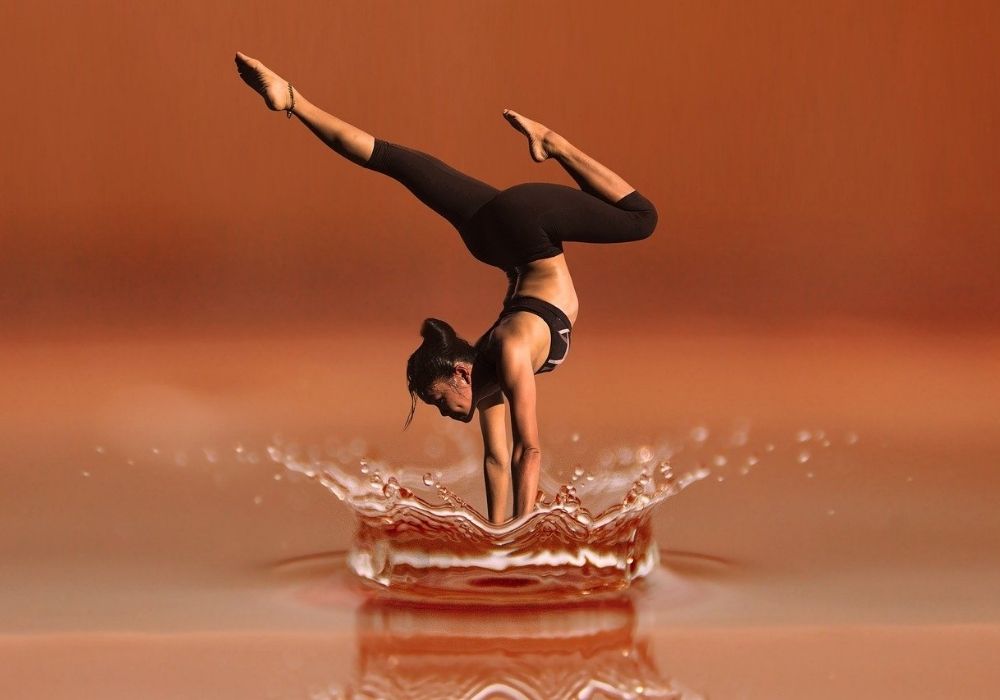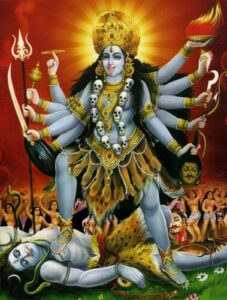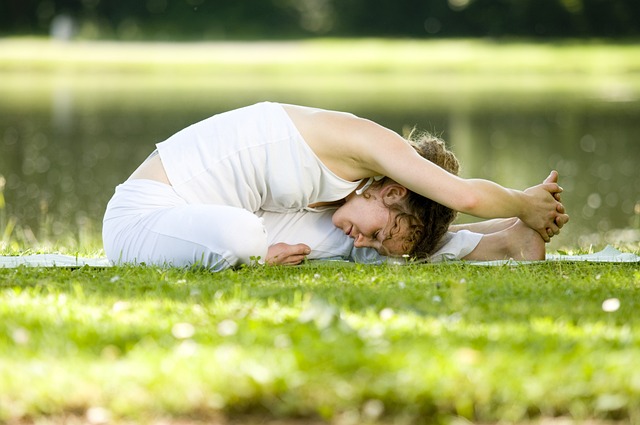
Below, you will find five easy yoga poses to help with insomnia. Please seek assistance for some of the poses using blocks or yoga belts and practice safely against a wall if needed.
1. Salamba Sarvangasana (Supported shoulder stand)
Alamba means a prop, a support and sa together with or accompanied by. Sarvanga (Sarva=all, whole, entire, complete; anga=limb or body) means entire body or all the limbs. In this pose the whole body benefits from the exercise, hence the name.
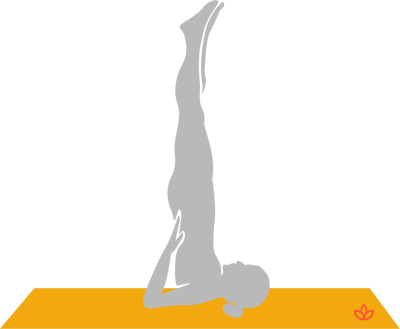
How to
- Lie flat on the mat or carpet keeping the legs stretched out, tightened at the knees. Place the hands by the side of the legs, palms down.
- Exhale, bend the knees and move thte legs toward the stomach till the thighs press it.
- Raise the hips from the floor with an exhalation and rest on them by bending the arms at the elbows. Breathe.
- Exhale, raise the trunk up perpendicularly supported by the hands until the chest touches the chin.
- Only the back of the head and the neck, the shoulders and the backs of the arms up to the elbows should rest on the floor. Place the hands in the middle of the spine as shown in picture. Breathe.
- Exhale stretch the legs straight with toes pointing up.
- Stay in this position for 5 minutes with even breathing.
- Exhale, gradually slide down, one vertebra at a time, bending the knees if it helps, release the hands, lie flat, and relax.
Effects
The importance of Sarvangasana cannot be over-emphasized. It is one of the greatest boons conferred on humanity by our ancient sages. Sarvangasana is the Mother of asanas. As a mother strives for harmony and happiness in the home, so this asana strives for the harmony and happiness of the human system. People suffering from high blood pressure should not attempt Salamba Sarvangasana unless they do Halasana first and can stay in it for not less than three minutes. This pose will aid with insomnia.
2. Paschimottanasana (Seated forward bend) | Insomnia
(Also called Ugrasana or Brhmacharyasana) Paschima literally means the west. It implies the back of the whole body from the head to the heels. The anterior or eastern aspect is the front of the body from the face down to the toes. The crown of the head is the upper or northern aspect while the soles and heels of the feet form the lower or southern aspect of the body. In this asana the back of the whole body is intensely stretched hence the name. Ugra means formidable, powerful, and noble. Brahmacharya means religious study, self-restraint and celibacy.

How to
- Sit on the floor with the legs stretched straight in front. Place the palms on the floor by the side of the hips. Take a few deep breaths.
- Exhale, extend the hands and catch the toes. Hold the right big toe between the right thumb and the index and middle fingers and likewise the left big toe.
- Extend the spine and try to keep the back concave. To start with the back will be like a hump. This is due to stretching the spine only from the area of the shoulders.
- Learn to bend right from the pelvic region of the back and also to extend the arms from the shoulders. Then the hump will disappear and the back will become flat as shown above. Breathe.
- Exhale, bend and widen the elbows, using them as levers, pull the trunk forward and touch the forehead to the knees.
- Gradually rest the elbows on the floor, stretch the neck and trunk, touch the knees with the nose and then with the lips.
- When this becomes easy, make a further effort to grip the soles and rest the chin on the knees. Try and stay in whichever position you can achieve from 1-5minutes.
- Inhale, raise the head from the knees and relax. This pose will aid with insomnia.
3. Uttanasana (standing forward bend) | Yoga for insomnia
(Ut is a particle indicating deliberation, intensity. The verb tan means to stretch, extend, lengthen out. In this pose, the spine is given a deliberate and an intense stretch)
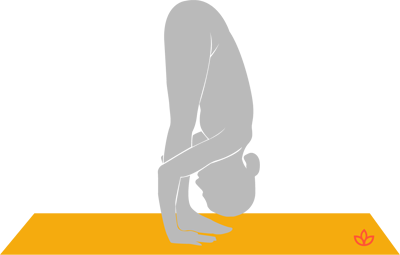
How to
- Stand erect at the top of the mat with feet together. Big toes touch and heels slightly apart.
- As you exhale bend forward and place the fingers on the floor.
- Move the hips a little forward so as to bring the legs perpendicular to the floor.
- Knees can stay slightly bent if hamstrings are too tight.
- Aim with your head straight down towards the feet.
- Hold this position up to a minute with deep and even breathing.
Effects
This pose cures stomach pains and tones the liver, the spleen, and the kidneys. It also relieves stomach pain during menstrual periods. Heals depression and rejuvenates the spinal nerves. It soothes brain cells, so the mind feels at peace. This pose will aid with insomnia.
4. Salamba Sirsasana (supported headstand)
Salamba means with support. Sirsa means the head. This is the headstand pose, one of the most important Yogic asanas. Its mastery gives one balance and poise, both physically and mentally.
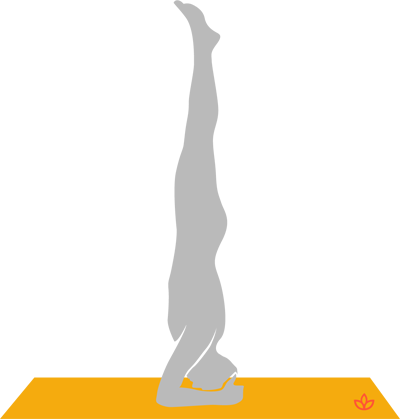
How to
- Use a yoga mat on the floor and kneel on it. (beginners must practice by a wall)
- Rest the forearms on the mat and keep the elbows about shoulder distance apart.
- Interlock the fingers so that the palms form a cup and place the sides of the palms on the mat. The finger should be kept tightly locked.
- Rest the crown of the head only on the mat, so that the back of the head touches the palms which are cupped.
- After securing the head position, raise the knees from the floor by walking the toes closer to the head.
- Exhale, take a gentle swing from the floor and lift the legs off the ground simultaneously with bent knees. (beginners should have assistance or try this asana against a wall for more support by hopping and kicking one leg up at a time until balancing with both legs extended)
- Stretch the legs and stand on the head, keeping the whole body perpendicular to the floor.
Hints on Sirsasana
In Sirsasana the balance alone is not important. One has to watch from moment to moment and fin out the subtle adjustments. When we stand on our feet, we need no extra effort, strength or attention, for the position is natural. Yet the correct method of standing affects our bearing and carriage. In Sirsasana also, the correct position should be mastered, as a faulty posture in this asana will lead to pains in the head, neck and back. This pose will aid with insomnia.
5. Savasana (corpse pose) | Yoga for insomnia
Sava means a corpse. In this asana the object is to imitate a corpse.

How to
- Lie flat on the back full length like a corpse. Keep the hands a little away from the thighs, with the palms up.
- Close the eyes. If possible place a black cloth folded four times over the eyes. Keep the feet apart or heels together and toes apart.
- To start with breathe deeply. Later the breathing should be fine and slow, with no jerky movements to disturb the spine of the body.
- The lower jaw should hang loose and not be clenched. The tongue should not be disturbed, and even the pupils of the eyes should be kept completely passive.
- Relax completely and breath out slowly.
- Stay in this pose up to 15 minutes.
Don’t miss this post on Ujjayi Pranayama (Breathing)
